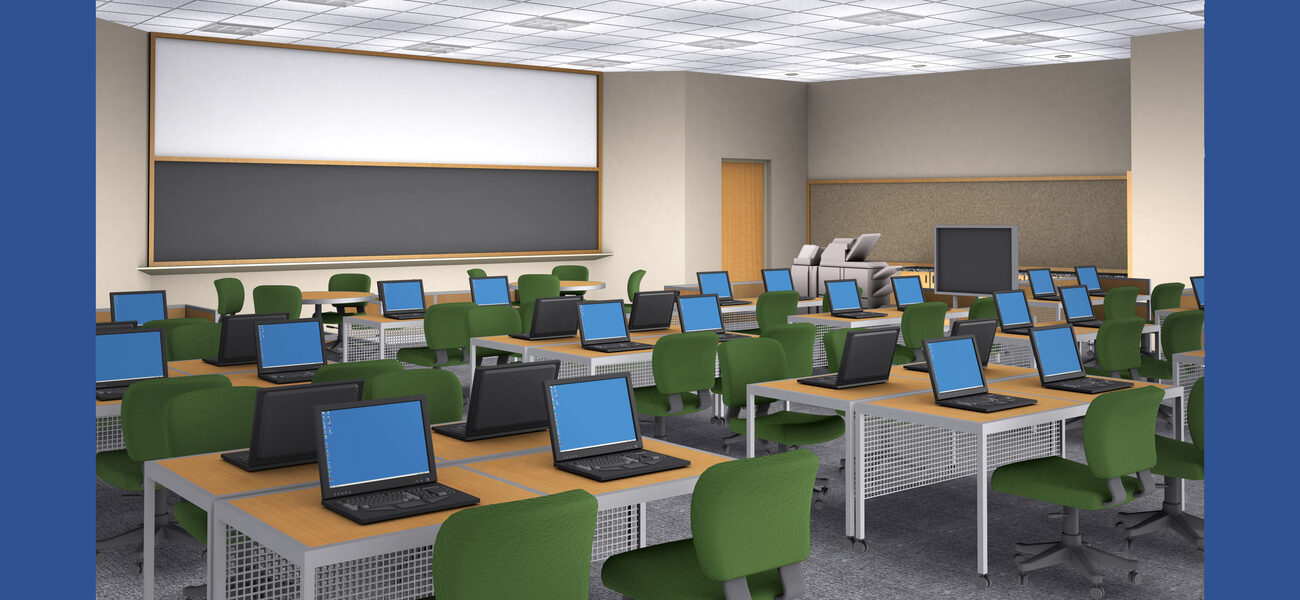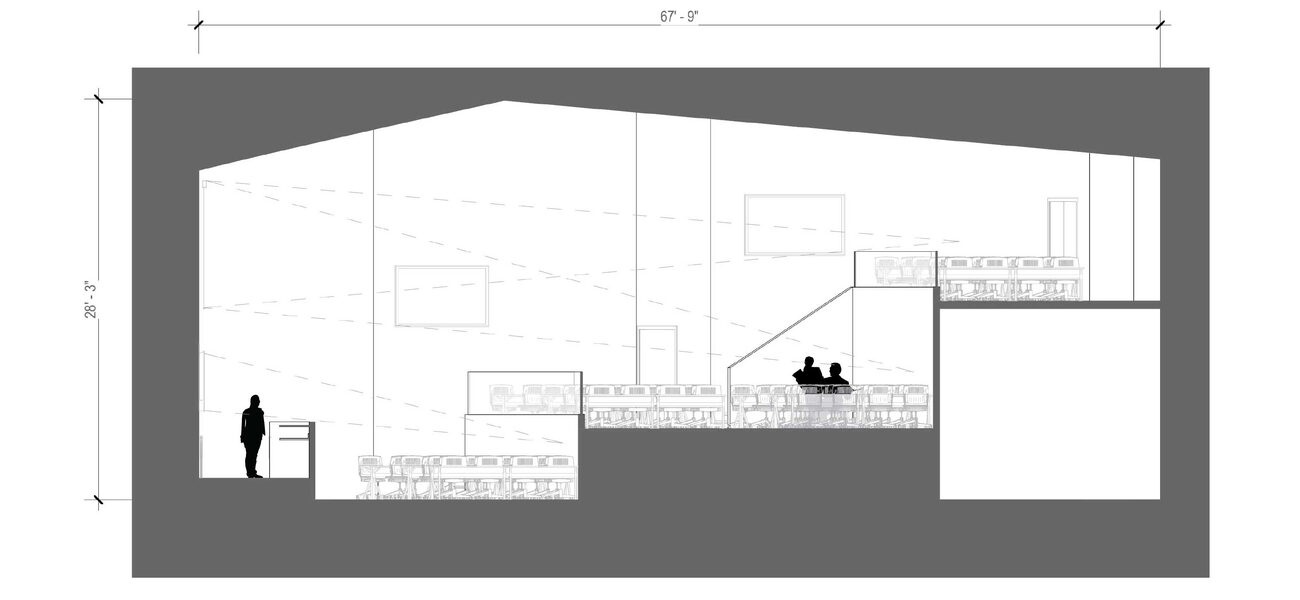You had a few of those big lecture classes in college—rows of students sitting in tiers, facing an instructor with an overhead projector or maybe a PowerPoint presentation. But recent studies show that students learn better and achieve more when they actively engage in their learning rather than passively listen to a lecture. Higher ed students will likely continue to spend about half their time in lecture halls or large-format classrooms designed for 75, 150, or even 250 people, so universities need to adapt these spaces with improved audiovisual systems and more room per student.
Jessica Orlando, practice leader for higher education at AECOM in Los Angeles, says refitting a large learning space is an interesting challenge that requires combining the new and the old for maximum benefit to students. One of the important considerations is understanding how today’s students learn. “When we actually look at performance, they are not finding any difference between students who go to class or students who stay at home and watch a recording of a lecture,” she says. “Students today are not really getting any benefit from going to a didactic-format lecture.”
So what does work? “Students are performing better in active learning pedagogies, where they are working on problems or on projects or in groups, where they are engaging directly with their peers, instructors or their TAs,” says Orlando. One recent study found that in STEM fields, active learning modalities can increase average performance by half a letter grade while also reducing failure rates.
She also points to a Gallup poll that found that two of the qualities most linked to students’ preparedness for post-college life were “strong connections with professors and mentors” and “hands-on experience applying knowledge”—qualities that are easiest to develop when students have the opportunity to connect with their instructors, with one another, and with the work.
A Room with a View
To create the most effective large learning space, universities should start by upgrading their audiovisual systems, says Orlando.
The first priority from the A/V perspective is making sure every student can see all the information being presented. Depending on the format of the existing space, this may take the form of multiple displays, larger displays, and better projectors. In addition, the technology in the room should support student tech, including the ability for students to share work from their devices with the class.
One important element in building more inclusive classrooms is assistive listening systems, which provide enhanced audio for students with hearing impairments. The technology is borrowed from performing arts venues, which often offer such adaptations. While assistive listening may seem like an expensive extra, the systems are often integrated with audio and video capture systems which use the same microphones and allow the instructor to stream the class online later. Ideally, the system would also capture student questions, comments, and presentations to provide all listeners with the full experience.
More Space per Student
The traditional lecture hall offers just 14 to 18 sf per student, which makes for a cramped educational setting, especially in a crowded class where everyone is using laptops and struggling to find space for the five other devices they typically carry. “It definitely takes some intent to make this a positive learning experience,” says Orlando.
Alternative floor plans offer various improvements on the one-row tiers, but it can be expensive to renovate older halls if the floor has been set in concrete and has building systems embedded underneath. Orlando strongly recommends that new tiers be constructed of lightweight material, such as lighter-gauge metal framing, so they can be removed later if the need for the space changes. It also can be hard to sell the idea of drastically decreasing the capacity of the room by giving students more space. “We are dealing with a lot of clients who say that they still need 250-seat lecture halls,” she says. “They likely don’t need as many as they think they do.”
If the rows of seating are not raked higher as they go back, it’s hard for everyone to see. If the rows are raked too high, people in the back can struggle to participate. “That point in the back starts to feel a little disconnected from the instructor and from the content that is happening in the room,” explains Orlando.
In addition, single-row seating makes it more difficult for students to do group work, and many tiered floor plans suffer from accessibility challenges that limit students with mobility issues to a couple of seats at best. Improving the situation is a priority at many institutions. “Everybody is focused on accessibility and inclusion,” says Orlando.
One potential workaround is to flatten out the tiers a bit, so that each tier includes two rows of seats instead of one. If the furnishings are also movable, this makes it easier for students to rearrange themselves into small groups for projects and discussions. Orlando points to a renovation at Indiana University, where a large lecture hall was reconfigured with more flexible seating, shallower and wider tiers, and walls covered in writable surfaces. The down side is that professor may have to rearrange the furniture for their class.
Another model offers restaurant-style “booths” as small-group spaces within a large room, but uses fixed furniture which limits both the size of the groups and the benefit of its expanded per-student area (about 25 to 35 sf). “You can’t move it, the group size can’t change, and the tiers are quite steep. Again, you're pretty challenged with accessibility,” says Orlando.
One renovation technique combines advanced AV and flexible furniture for maximum student access, with power in the walls and in the floor, AV all around the room, and many different vantage points. “The AV cost is going up in order to support that,” she says.
‘Not Going Away’
Orlando encourages institutions to prioritize interaction among students in designing and configuring large academic spaces. “These types of spaces are not going away,” she says. “The ability to teach this number of students is still a necessity.”
At the same time, no one knows exactly what changes are coming in education, technology, or learning styles, so “flexibility is key,” says Orlando.
Finally, accessibility and inclusion are increasingly important, as universities seek to expand the number of learners who can benefit from their programs. “What we’re hearing more and more from our clients is that they want the room to be fully accessible,” she says. “They don’t want anyone who has a physical disability to feel like they are excluded from any part of the space.”
What does it look like to create a space that meets those needs for interaction, flexibility, and accessibility? Orlando cautions that while more space per student is often helpful, it’s not a solution to every challenge. She points to a survey of first-year medical students who said they preferred a variety of education styles, but if they had to choose one, they most valued hands-on (kinesthetic) experiences.
Her proposed classroom starts with a radial plan, so that seating curves gently around the instructor station to maximize comfortable sightlines for every seat. The instructor’s area is slightly raised from the floor, for better connection with people at the back. Glass railings help increase visibility. There are still tiers of seating, but they are large enough to accommodate movable tables and seats for students working in groups, and each tier, including the instructor station, is accessible to people with mobility equipment.
Orlando says group sizes in schools overseas are often larger than in the U.S., but even American university classes are seeing larger study groups of six to eight students instead of four, for example. Thus, a flexible classroom allows tables and seating to be combined for larger and smaller cohorts.
The COVID-19 pandemic, in addition to causing abrupt disarray in academic life, has prompted schools to consider how they can do things differently, including updating old-school lecture formats. “The biggest thing we’re seeing is that some of the very traditional holdouts are starting to rethink that model,” Orlando says.
By Patricia Washburn



